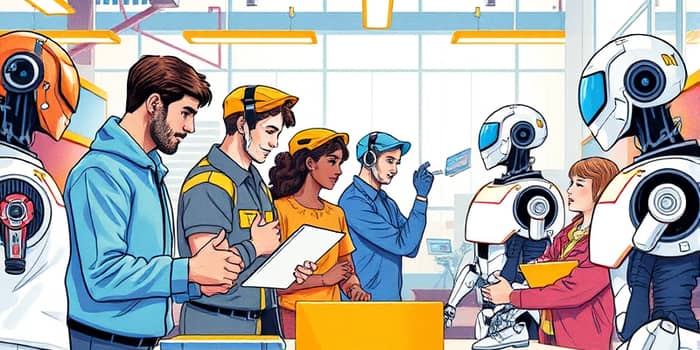
As artificial intelligence and automation accelerate, economies and societies face an unprecedented crossroads. Policy makers, businesses, and workers must unite to shape a future where innovation and human dignity coexist.
In this article, we examine the scale of disruption, the emotional toll on workers, and a playbook of policy responses that can steer us toward shared prosperity.
By 2025, up to 85 million jobs will be displaced globally, while 97 million new roles emerge, yielding a net gain of 12 million jobs. Yet nearly 300 million positions—roughly 9.1% of all employment—could ultimately be automated.
Industries with the highest risk include customer service (80%), retail cashiers (65%), and data entry roles, with 7.5 million jobs at threat by 2027. Transportation and manufacturing each face the risk of losing over a million positions by 2030.
In the United States, 47% of workers face displacement risk in the next decade, with women (58.9 million) slightly more exposed than men (48.6 million). Corporate surveys reveal 41% of employers plan workforce reductions due to AI within five years.
The future workplace will be defined by a powerful blend of human-AI collaboration. Rather than a simple replacement, automation can handle routine tasks, freeing employees for creative problem-solving and strategic work.
Yet transitions demand a massive shift in skill requirements—77% of new AI-related roles need a master’s degree or equivalent. Entry-level positions in manufacturing and customer service will continue to shrink without targeted support.
Flexibility will also reshape how we work. Hybrid remote arrangements, reskilling sabbaticals, and modular career paths can help individuals adapt to evolving job descriptions and technologies.
Automation drives increased productivity, but it also exerts downward wage pressure, especially for routine tasks. Without intervention, inequality can widen, as high-skilled roles command premium salaries while low-skill positions erode.
Equity concerns extend to demographic disparities: less-educated, older, and minority workers face greater barriers to transition. Ensuring fair access to training and benefits is essential for an inclusive recovery.
Beyond numbers, the human experience reflects fear, uncertainty, and hope. Surveys show 30% of American workers worry about AI replacing their job by 2025, and 13.7% report losing work to automation already.
Communication and transparency can alleviate anxiety. Organizations that share roadmaps for automation, offer retraining, and honor employee input see higher morale and greater trust—critical ingredients for resilience.
Addressing automation’s challenges requires a multi-layered strategy. Governments, businesses, and educational institutions must collaborate on comprehensive solutions.
Education reform is also vital. Curricula must emphasize critical thinking, digital literacy, and creativity, preparing students for roles that cannot be automated. Likewise, social policies such as universal basic income pilots and strengthened unemployment insurance can cushion abrupt transitions.
While experts agree automation will reshape many occupations between 2025 and 2035, they debate the pace and net impact. Some forecasts highlight a net gain of 78 million jobs by 2030, while others caution that without intervention, structural unemployment and inequality may rise.
An international insurance firm publicly shared its automation roadmap, invested in retraining, and used natural attrition to moderate layoffs. The result was a significant boost in employee engagement and retention.
In contrast, several large tech firms announced 77,999 AI-related layoffs in early 2025, illustrating the risks when corporate strategies lack a human-centered approach. These cases underscore the importance of balanced policies that safeguard both innovation and well-being.
The stakes of automation extend beyond economic growth—they touch on social cohesion, individual dignity, and global competitiveness. By embracing a public-private partnerships for workforce development and prioritizing data transparency and algorithmic accountability, we can navigate this transformation together.
The future of work is neither predetermined nor dystopian. With thoughtful policy, collective effort, and a commitment to equity, automation can become a force for shared prosperity and human flourishing.
References





